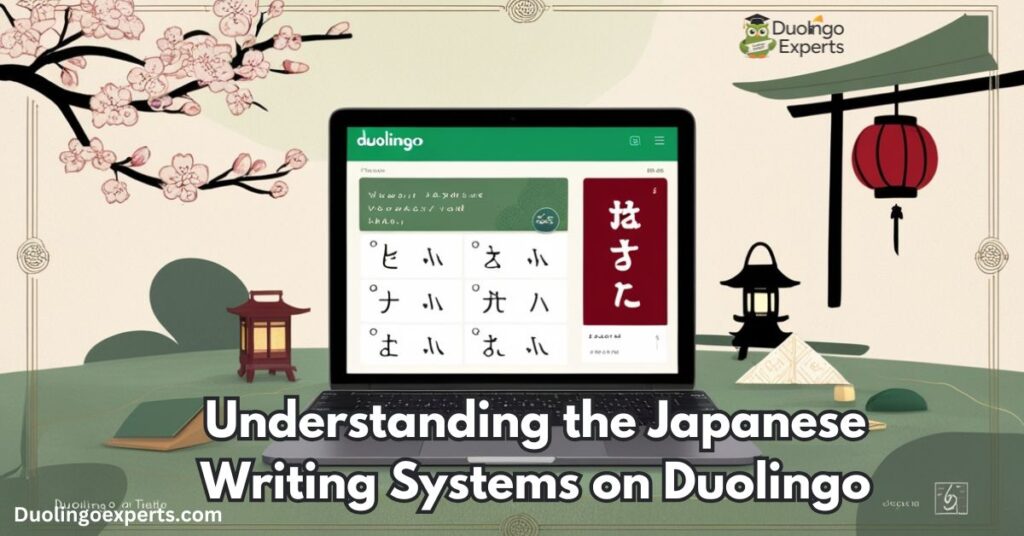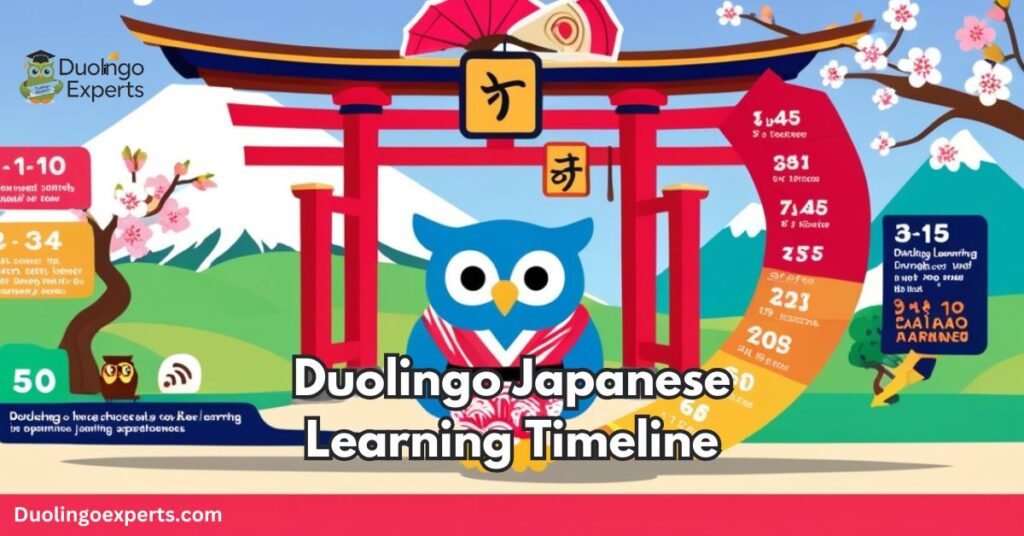Learning Japanese can be an exciting and rewarding journey, but it’s not without its challenges. Whether you’re a beginner or looking to build on existing knowledge, Duolingo has quickly become one of the most accessible and popular platforms to help people learn languages, including Japanese. With its user-friendly, gamified structure, Duolingo promises to make learning Japanese both engaging and effective. But how long does it take to learn Japanese on Duolingo? How can you structure your study sessions for success?
In this comprehensive guide, we’ll take a deep dive into everything you need to know about learning Japanese on Duolingo, including the Japanese writing systems, how long it will take, the course structure, and the best tips to reach your Japanese fluency goals.
Understanding the Japanese Writing Systems on Duolingo
Before you can start speaking Japanese with confidence, it’s important to learn the basics of how the language is written. Japanese uses three main writing systems: Hiragana, Katakana, and Kanji.

Understanding these systems is crucial to mastering the language. Fortunately, Duolingo introduces these writing systems step-by-step, starting with the basics.
Hiragana Characters and Basic Sounds
The first step in learning Japanese is mastering Hiragana, a phonetic alphabet used for native Japanese words, grammatical markers, and verb endings. There are 46 basic Hiragana characters, each representing a sound or syllable. Some characters, like あ (a), い (i), う (u), are simple to learn, while others require more practice to remember.
Key Features of Hiragana on Duolingo:
- Tracing Exercises: One of the first ways Duolingo introduces Hiragana is through tracing. Tracing each character helps you internalize the stroke order, a fundamental skill for writing in Japanese.
- Sound Reinforcement: As you learn each Hiragana character, you’ll hear it pronounced by a native speaker, allowing you to associate the character with its sound.
- Quiz-Based Learning: Duolingo uses quizzes and multiple-choice questions to reinforce Hiragana. You’ll be asked to match characters with sounds or select the correct character for a word.
Katakana for Foreign Words
Once you have a solid understanding of Hiragana, Duolingo will introduce you to Katakana, the script used primarily for borrowed words or foreign terms. While Hiragana is used for native words, Katakana represents words that have been imported from other languages, such as “coffee” (コーヒー) or “computer” (コンピュータ).
Learning Katakana is crucial for expanding your vocabulary, especially if you plan to travel to Japan or use modern technology, as many products and terms are written in Katakana.
How Duolingo Teaches Katakana:
- Comparing Hiragana and Katakana: Duolingo ensures that you can distinguish between Hiragana and Katakana, so you know when to use each script.
- Practical Vocabulary: Duolingo integrates useful Katakana words into lessons on topics like shopping, food, and travel, giving you the tools to communicate in everyday situations.
Kanji Integration and Practice
After you’re comfortable with Hiragana and Katakana, Duolingo will introduce Kanji, the logographic characters borrowed from Chinese. Kanji can represent entire words, concepts, or ideas, making them more complex than Hiragana or Katakana. There are thousands of Kanji characters, but Duolingo focuses on the most common ones, introducing them gradually.
Kanji on Duolingo:
- Gradual Learning: Duolingo introduces Kanji in small chunks, starting with the most frequently used characters. As you progress, you’ll encounter more complex Kanji.
- Interactive Practice: Duolingo uses its trademark game-like interface to help you recognize Kanji characters and learn how to use them in sentences.
- Vocabulary Reinforcement: As you learn more Kanji, Duolingo reinforces them through quizzes and vocabulary exercises. You’ll also see Kanji paired with Hiragana for pronunciation and context.
How Long Does It Take to Learn Japanese on Duolingo?
One of the most common questions learners have is: How long does it take to become fluent in Japanese on Duolingo? Learning Japanese is a long-term process, and Duolingo provides a strong foundation, but the time it takes to reach fluency depends on multiple factors, including your prior experience with the language, the amount of time you commit daily, and your overall learning goals.
Duolingo Japanese Learning Timeline

Learning Japanese takes time, and Duolingo’s approach is progressive, with learners starting with simple topics before advancing to more complex concepts. Here’s an estimated timeline for reaching various levels of proficiency:
- Beginner (1-3 months): In the first 1-3 months, you’ll primarily focus on Hiragana, Katakana, and basic vocabulary. You’ll learn how to greet people, introduce yourself, and talk about simple things like your hobbies and the weather.
- Intermediate (3-6 months): After 3-6 months of regular practice, you should be able to engage in basic conversations, understand simple sentences, and begin using Kanji. You’ll also expand your vocabulary to include more everyday topics like shopping, family, and food.
- Advanced (6-12 months): At the 6-12 month mark, you’ll tackle more advanced subjects, including Kanji, complex sentence structures, and intermediate conversational topics. At this stage, you should be able to understand and participate in conversations about work, travel, and social topics.
- Fluent (1-2 years): Achieving fluency in Japanese typically takes 1-2 years on Duolingo with consistent practice. While Duolingo helps you build a solid foundation, fluency in Japanese requires immersive learning and practice beyond Duolingo, such as speaking with native speakers and consuming Japanese media.
Factors That Affect Your Learning Speed
Several factors can influence how quickly you progress on Duolingo:
- Consistency: Daily practice is key. Spending 20-30 minutes per day on Duolingo is much more effective than cramming for hours once a week.
- Supplementary Learning: While Duolingo is a fantastic resource, you’ll want to supplement it with other tools, like language exchange apps, podcasts, and grammar books.
- Language Background: If you already know a language that uses a similar structure (such as Korean), you might pick up Japanese faster.
Duolingo Japanese Course Structure

Duolingo’s Japanese course structure is designed to guide you through a systematic progression. It’s broken into 142 units, each covering different topics and grammar points. Each unit contains a set of lessons and exercises that will help you practice specific areas of the language, from vocabulary to sentence structure.
Topic Progression Through Units
The topics in the Duolingo Japanese course cover a wide range of areas, and as you progress, the difficulty increases. The units start with simple greetings and basic phrases, and gradually move to more complex topics like business, politics, and technology. Here’s how the progression works:
- Unit 1-4: Basic Greetings, Introductions, Numbers, and Everyday Vocabulary
- Unit 5-10: Family, Weather, Hobbies, and More Daily Conversation Topics
- Unit 11-20: Intermediate Topics like Food, Shopping, and Travel
- Unit 21-30: Advanced Topics including Work, Health, and Social Issues
- Unit 31-50: Specialized Vocabulary (Science, Technology, Politics)
- Unit 51-100: Kanji mastery, advanced grammar, sentence construction
Duolingo Interactive Features for Learning Japanese Characters
Duolingo’s interactive features make learning Japanese engaging. Here’s how Duolingo uses its tools to make the process more enjoyable:
- Multiple-choice quizzes help reinforce vocabulary and sentence structure.
- Matching exercises test your ability to pair words with their meanings or translations.
- Timed challenges and puzzles keep you on your toes and make learning fun.
Tracing Japanese Characters and Stroke Order
Duolingo provides a unique approach to learning Japanese writing systems. In particular, stroke order is crucial for writing Hiragana, Katakana, and Kanji correctly. Tracing exercises in the app guide you through the process, ensuring that you learn the proper sequence for each stroke.
Why Stroke Order Matters:
- Legibility: Correct stroke order makes your handwriting more legible.
- Efficiency: Knowing the correct order helps you write faster and more accurately.
- Memory: Learning stroke order reinforces your understanding of the characters.
Daily Time Investment Requirements
To achieve consistent progress with Duolingo, you need to invest time each day. Ideally, you should aim to spend 20-30 minutes per day, five to six days a week. Here’s a breakdown of the time commitment for each phase of your learning:
- Beginners: 15-20 minutes per day focusing on character recognition and basic vocabulary.
- Intermediate learners: 25-30 minutes per day, practicing new vocabulary, sentence structures, and Kanji.
- Advanced learners: 30 minutes to 1 hour per day for more complex lessons, grammar, and conversations.
Practice Methods and Study Techniques
While Duolingo is a powerful tool, there are several other study techniques you can use to complement your learning:
Vocabulary Reinforcement
- Use flashcards (apps like Anki) to memorize new words and Kanji.
- Practice Kanji stroke order through writing exercises outside Duolingo.
Listening and Speaking Practice
- Engage in language exchanges using apps like HelloTalk or iTalki.
- Watch Japanese TV shows, movies, or YouTube channels to immerse yourself in the language.
Grammar Books and Resources
- Supplement Duolingo with grammar books like Genki or Minna no Nihongo to deepen your understanding of Japanese sentence structure.
Consistency is Key
Remember, consistency is essential. Daily review for language retention is necessary to ensure that you don’t forget what you’ve learned.
Frequently Asked Questions (FAQ)
How long does it take to learn Japanese on Duolingo?
It typically takes about 2 to 3 years to achieve conversational fluency with consistent practice. You will see initial progress within 3-6 months, but fluency requires continuous learning.
Can you learn Japanese on Duolingo?
Yes, Duolingo is an excellent tool for beginners and intermediate learners. It offers a strong foundation in grammar, vocabulary, and writing systems.
How is the Duolingo Japanese course structured?
The course is broken into 142 units, each focusing on specific vocabulary, grammar, and writing systems. The lessons gradually increase in difficulty.
What interactive features does Duolingo offer for learning Japanese characters?
Duolingo includes tracing exercises, multiple-choice quizzes, and vocabulary reinforcement exercises to help you master Hiragana, Katakana, and Kanji.
How can I achieve Japanese fluency goals on Duolingo?
To reach fluency, practice daily, engage with native speakers, and supplement Duolingo with additional resources like grammar books, podcasts, and language exchanges.
How long to finish Japanese Duolingo?
The time it takes to finish the Japanese Duolingo course varies depending on your learning pace, but on average, it takes about 6 months to a year for consistent learners to complete the entire course. For beginners aiming for basic fluency, it could take around 1-2 years of regular practice.
How long does it take to learn Japanese on Duolingo after?
After completing the Duolingo course, achieving fluency in Japanese typically takes an additional 1-2 years of consistent practice, including speaking and real-world application. The timeline can vary depending on how much time you invest in immersion and conversation practice.
How long does it take to learn fluent Japanese on Duolingo?
Achieving fluent Japanese on Duolingo typically takes 1-2 years of consistent daily practice. Progress depends on your commitment to practicing speaking, listening, and immersion alongside the app’s structured lessons.
How long does it take to learn Japanese fluently on Duolingo?
Becoming fluent in Japanese on Duolingo generally takes 1-2 years with regular practice. Fluency depends on additional immersion, conversation practice, and consistent review beyond the app’s lessons.
Conclusion
Learning Japanese on Duolingo is a highly effective way to start your journey toward fluency. While it’s not enough to achieve complete mastery on its own, Duolingo provides an excellent foundation. By following the Japanese language learning timeline, using Duolingo’s interactive features, and practicing consistently, you can build a solid understanding of Japanese grammar, vocabulary, and writing systems. With dedication, you’ll reach your Japanese fluency goals and be ready to converse in Japanese confidently.
>>>Read Also: Duolingo Math: Master Math Skills with Fun and Engaging Lessons

DuolingoExperts, managed by MarkJohan, offers expert insights and tips for mastering languages. A tech-driven platform to enhance your learning experience.

